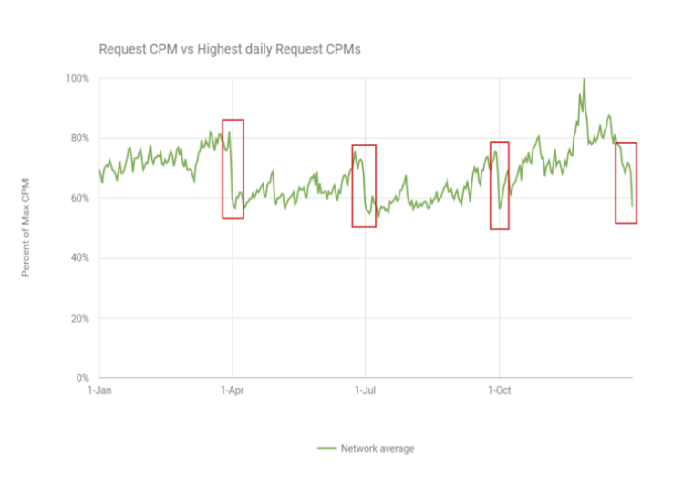Why AdSense Earnings Often Decrease in January (And What to Do About It)

The final quarter of the year is often referred to as “the golden quarter” by publishers due to the skyrocketing ad spend by advertisers wanting to reach customers in this peak shopping period.
Increased ad spend leads to more competitive auctions and higher RPMs for publishers, which often makes Q4 the most profitable time of the year.
Unfortunately, the highs experienced at the end of the calendar year are short-lived and when it comes to January, many digital publishers find that their ad revenue has dramatically slumped. Luckily for us, the lows of Q1 are also temporary. These predictable fluctuations recur throughout the calendar year and are defined as Seasonality.
As an AdSense publisher, it is important to understand the patterns that occur during seasonal periods, as this will help you avoid time wasted on diagnosing issues out of your control.
Factors that Drive AdSense Seasonality
As with any drop in revenue, the best starting point is to understand the issue. There are two main factors that drive seasonal spikes and dips in publishers’ ad revenue:
I. Web traffic
At the end of Q4, there are generally more people surfing the web for Thanksgiving, Black Friday, Christmas and the other December holidays. This means that more ad impressions are served as a result of the increase in traffic.
Conversely, at the beginning of Q1 most people have completed their shopping so there is often a decrease in traffic and therefore a drop in ad requests. If there are fewer people on your website, it’s more than likely that you’ll experience a lower click-through rate.
A drop in web traffic can easily be diagnosed by using Google Analytics to compare traffic year-on-year.

II. RPMs
Publishers’ ad revenue depends heavily on how much advertisers are willing to spend on their inventory. Marketers tend to be more conservative when spending advertising budgets at the beginning of the calendar year. This is because the beginning of the quarter is usually seen as an opportunity for advertisers to experiment and assess which campaigns perform best.
In contrast, advertisers tend to concentrate a large proportion of their budget at the end of Q4 advertisers as they know that more people will be closer to the point of purchase at this time. This is also a time for any unspent budget to be used up on high-intensity campaigns.
Understand the Quarterly Buying Cycle
The drop at the end of the fourth quarter is the most noticeable due to the high rates proceeding it, but it happens on a smaller scale every quarter.
The predictable and sudden drops experienced at the end of quarters occur because of the way that digital advertising campaigns are bought and booked.
Marketers are usually set quarterly budgets to run campaigns during those calendar quarters. As many large ad campaigns end at the same time, demand tends to drop off and publisher revenue follows. These patterns are usually reflected in publisher earnings from the beginning of the following quarter as consumer spend and traffic decreases.

SOURCE: OKO Digital
Best Steps to Prepare Your AdSense Website for Q1
Here’s what to do if your ad revenue drops in January:
1. Continue to post relevant and engaging content
Use Google Trends to see what search queries were trending last January and see if you can use this data as inspiration for future content. This will ensure that you are posting relevant and engaging content for your users.
Topics that typically trend at the beginning of the quarter include weight loss, travel and any upcoming holidays such as Valentine’s day.
2. Experiment with your AdSense placements
Advertisers use the beginning of the quarter to experiment with their ad campaigns and publishers should too.
Using suggestions obtained from the ‘Optimization’ tab, carry out some A/B split testing experiments to help you make more informed decisions on your ad placements.
3. Promote your website
The beginning of the quarter is a good time to utilize mailing lists and social sharing to promote your website and encourage visitors to return.
Whilst it may be tough to attract new visitors to your site during downtimes, keeping current visitors engaged will increase your pageviews.
4. Check your site’s health
January is a good time to check on your site’s overall health. Could the user experience be improved? What is the load time like? Are there any issues that need fixing?
5. Take inspiration from larger websites
Most web publishers deal with seasonality to an extent and some are likely to be more experienced than you in dealing with the fluctuations that Q1 brings.
Take a look at sites larger than yours to gain an insight into what larger websites do to mitigate the impact of January ad revenue loss.




















